







Content
The Great Debate: Air Cooling vs. Liquid Cooling for Your PC
The Great Debate: Air Cooling vs. Liquid Cooling for Your PC
The Great Debate: Air Cooling vs. Liquid Cooling for Your PC
The Great Debate: Air Cooling vs. Liquid Cooling for Your PC
The Great Debate: Air Cooling vs. Liquid Cooling for Your PC
The Great Debate: Air Cooling vs. Liquid Cooling for Your PC
The Great Debate: Air Cooling vs. Liquid Cooling for Your PC





31-Jul-2024
31-Jul-2024
31-Jul-2024
31-Jul-2024
31-Jul-2024





6 mins
6 mins
6 mins
6 mins
6 mins
When building a PC, keeping your components cool is crucial. But with two main options – air cooling and liquid cooling – choosing the right one can feel overwhelming. Fear not, tech enthusiasts! This guide dives deep into the differences between these cooling solutions, helping you pick the perfect match for your build.
When building a PC, keeping your components cool is crucial. But with two main options – air cooling and liquid cooling – choosing the right one can feel overwhelming. Fear not, tech enthusiasts! This guide dives deep into the differences between these cooling solutions, helping you pick the perfect match for your build.
When building a PC, keeping your components cool is crucial. But with two main options – air cooling and liquid cooling – choosing the right one can feel overwhelming. Fear not, tech enthusiasts! This guide dives deep into the differences between these cooling solutions, helping you pick the perfect match for your build.
When building a PC, keeping your components cool is crucial. But with two main options – air cooling and liquid cooling – choosing the right one can feel overwhelming. Fear not, tech enthusiasts! This guide dives deep into the differences between these cooling solutions, helping you pick the perfect match for your build.
When building a PC, keeping your components cool is crucial. But with two main options – air cooling and liquid cooling – choosing the right one can feel overwhelming. Fear not, tech enthusiasts! This guide dives deep into the differences between these cooling solutions, helping you pick the perfect match for your build.
When building a PC, keeping your components cool is crucial. But with two main options – air cooling and liquid cooling – choosing the right one can feel overwhelming. Fear not, tech enthusiasts! This guide dives deep into the differences between these cooling solutions, helping you pick the perfect match for your build.
When building a PC, keeping your components cool is crucial. But with two main options – air cooling and liquid cooling – choosing the right one can feel overwhelming. Fear not, tech enthusiasts! This guide dives deep into the differences between these cooling solutions, helping you pick the perfect match for your build.
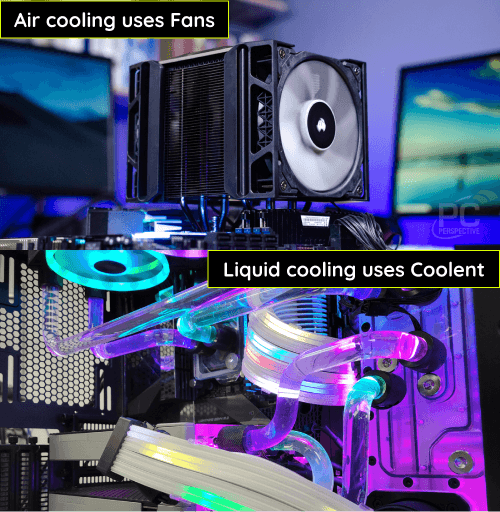







Installation: Simplicity vs. Complexity
Installation: Simplicity vs. Complexity
Installation: Simplicity vs. Complexity
Installation: Simplicity vs. Complexity
Installation: Simplicity vs. Complexity
Installation: Simplicity vs. Complexity
Installation: Simplicity vs. Complexity
Air Cooling: Breezy and straightforward. Most air coolers come with hassle-free mounting mechanisms. Simply attach the heatsink and fan to your CPU and plug it into the motherboard.
Liquid Cooling: Can be trickier. Mounting the water block, connecting tubes, and securing the radiator and fans require more effort. Liquid coolers may also require additional tools and careful handling to avoid leaks.
Air Cooling: Breezy and straightforward. Most air coolers come with hassle-free mounting mechanisms. Simply attach the heatsink and fan to your CPU and plug it into the motherboard.
Liquid Cooling: Can be trickier. Mounting the water block, connecting tubes, and securing the radiator and fans require more effort. Liquid coolers may also require additional tools and careful handling to avoid leaks.
Air Cooling: Breezy and straightforward. Most air coolers come with hassle-free mounting mechanisms. Simply attach the heatsink and fan to your CPU and plug it into the motherboard.
Liquid Cooling: Can be trickier. Mounting the water block, connecting tubes, and securing the radiator and fans require more effort. Liquid coolers may also require additional tools and careful handling to avoid leaks.
Air Cooling: Breezy and straightforward. Most air coolers come with hassle-free mounting mechanisms. Simply attach the heatsink and fan to your CPU and plug it into the motherboard.
Liquid Cooling: Can be trickier. Mounting the water block, connecting tubes, and securing the radiator and fans require more effort. Liquid coolers may also require additional tools and careful handling to avoid leaks.
Air Cooling: Breezy and straightforward. Most air coolers come with hassle-free mounting mechanisms. Simply attach the heatsink and fan to your CPU and plug it into the motherboard.
Liquid Cooling: Can be trickier. Mounting the water block, connecting tubes, and securing the radiator and fans require more effort. Liquid coolers may also require additional tools and careful handling to avoid leaks.
Air Cooling: Breezy and straightforward. Most air coolers come with hassle-free mounting mechanisms. Simply attach the heatsink and fan to your CPU and plug it into the motherboard.
Liquid Cooling: Can be trickier. Mounting the water block, connecting tubes, and securing the radiator and fans require more effort. Liquid coolers may also require additional tools and careful handling to avoid leaks.
Air Cooling: Breezy and straightforward. Most air coolers come with hassle-free mounting mechanisms. Simply attach the heatsink and fan to your CPU and plug it into the motherboard.
Liquid Cooling: Can be trickier. Mounting the water block, connecting tubes, and securing the radiator and fans require more effort. Liquid coolers may also require additional tools and careful handling to avoid leaks.
Maintenance: Dust Bunnies vs. Vigilance
Maintenance: Dust Bunnies vs. Vigilance
Maintenance: Dust Bunnies vs. Vigilance
Maintenance: Dust Bunnies vs. Vigilance
Maintenance: Dust Bunnies vs. Vigilance
Maintenance: Dust Bunnies vs. Vigilance
Maintenance: Dust Bunnies vs. Vigilance
Air cooling systems require minimal maintenance, with regular cleaning of the fans and heatsink to remove dust buildup.
Liquid cooling systems need more attention. While closed-loop systems (AIO coolers) require less maintenance, custom loop systems need periodic checking for leaks, coolant levels, and potential clogging. Regular maintenance ensures optimal performance but adds complexity and time investment.
The Perfect CPU cooler to maintain:
Noctua NH-D15
Known for its excellent cooling performance and quiet operation, the NH-D15 is one of the best air coolers available. It's relatively easy to install and maintain, making it a top choice for many PC builders
Air cooling systems require minimal maintenance, with regular cleaning of the fans and heatsink to remove dust buildup.
Liquid cooling systems need more attention. While closed-loop systems (AIO coolers) require less maintenance, custom loop systems need periodic checking for leaks, coolant levels, and potential clogging. Regular maintenance ensures optimal performance but adds complexity and time investment.
The Perfect CPU cooler to maintain:
Noctua NH-D15
Known for its excellent cooling performance and quiet operation, the NH-D15 is one of the best air coolers available. It's relatively easy to install and maintain, making it a top choice for many PC builders
Air cooling systems require minimal maintenance, with regular cleaning of the fans and heatsink to remove dust buildup.
Liquid cooling systems need more attention. While closed-loop systems (AIO coolers) require less maintenance, custom loop systems need periodic checking for leaks, coolant levels, and potential clogging. Regular maintenance ensures optimal performance but adds complexity and time investment.
The Perfect CPU cooler to maintain:
Noctua NH-D15
Known for its excellent cooling performance and quiet operation, the NH-D15 is one of the best air coolers available. It's relatively easy to install and maintain, making it a top choice for many PC builders
Air cooling systems require minimal maintenance, with regular cleaning of the fans and heatsink to remove dust buildup.
Liquid cooling systems need more attention. While closed-loop systems (AIO coolers) require less maintenance, custom loop systems need periodic checking for leaks, coolant levels, and potential clogging. Regular maintenance ensures optimal performance but adds complexity and time investment.
The Perfect CPU cooler to maintain:
Noctua NH-D15
Known for its excellent cooling performance and quiet operation, the NH-D15 is one of the best air coolers available. It's relatively easy to install and maintain, making it a top choice for many PC builders
Air cooling systems require minimal maintenance, with regular cleaning of the fans and heatsink to remove dust buildup.
Liquid cooling systems need more attention. While closed-loop systems (AIO coolers) require less maintenance, custom loop systems need periodic checking for leaks, coolant levels, and potential clogging. Regular maintenance ensures optimal performance but adds complexity and time investment.
The Perfect CPU cooler to maintain:
Noctua NH-D15
Known for its excellent cooling performance and quiet operation, the NH-D15 is one of the best air coolers available. It's relatively easy to install and maintain, making it a top choice for many PC builders
Air cooling systems require minimal maintenance, with regular cleaning of the fans and heatsink to remove dust buildup.
Liquid cooling systems need more attention. While closed-loop systems (AIO coolers) require less maintenance, custom loop systems need periodic checking for leaks, coolant levels, and potential clogging. Regular maintenance ensures optimal performance but adds complexity and time investment.
The Perfect CPU cooler to maintain:
Noctua NH-D15
Known for its excellent cooling performance and quiet operation, the NH-D15 is one of the best air coolers available. It's relatively easy to install and maintain, making it a top choice for many PC builders
Air cooling systems require minimal maintenance, with regular cleaning of the fans and heatsink to remove dust buildup.
Liquid cooling systems need more attention. While closed-loop systems (AIO coolers) require less maintenance, custom loop systems need periodic checking for leaks, coolant levels, and potential clogging. Regular maintenance ensures optimal performance but adds complexity and time investment.
The Perfect CPU cooler to maintain:
Noctua NH-D15
Known for its excellent cooling performance and quiet operation, the NH-D15 is one of the best air coolers available. It's relatively easy to install and maintain, making it a top choice for many PC builders
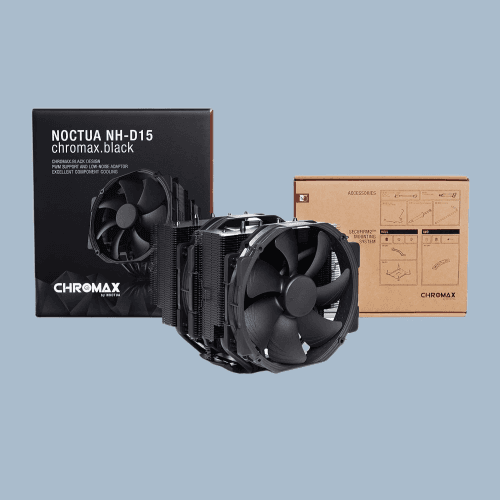







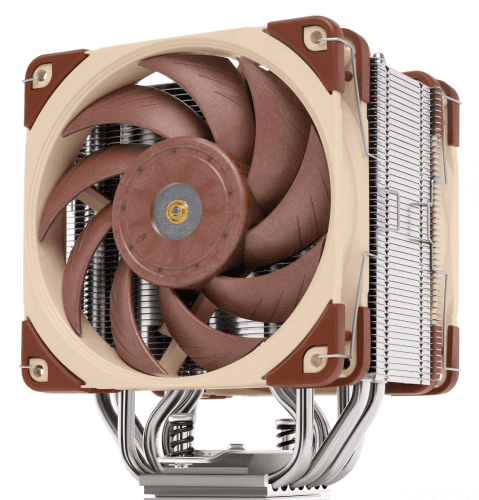







Noise Level
Noise Level
Noise Level
Noise Level
Noise Level
Noise Level
Noise Level
Air coolers can generate noticeable noise, especially under heavy loads when the fans spin at higher speeds. High-performance fans tend to be louder, which can be distracting.
Liquid cooling systems are generally quieter, with fans on the radiator running at lower speeds while still providing effective cooling, resulting in less noise.
A Quiet CPU cooler you can check:
Noctua NH-U12A:
This is a premium quiet cooler with two 120mm fans that generate up to 22.6 dBA of noise. It provides excellent cooling performance and is compatible with a wide range of CPU sockets
Air coolers can generate noticeable noise, especially under heavy loads when the fans spin at higher speeds. High-performance fans tend to be louder, which can be distracting.
Liquid cooling systems are generally quieter, with fans on the radiator running at lower speeds while still providing effective cooling, resulting in less noise.
A Quiet CPU cooler you can check:
Noctua NH-U12A:
This is a premium quiet cooler with two 120mm fans that generate up to 22.6 dBA of noise. It provides excellent cooling performance and is compatible with a wide range of CPU sockets
Air coolers can generate noticeable noise, especially under heavy loads when the fans spin at higher speeds. High-performance fans tend to be louder, which can be distracting.
Liquid cooling systems are generally quieter, with fans on the radiator running at lower speeds while still providing effective cooling, resulting in less noise.
A Quiet CPU cooler you can check:
Noctua NH-U12A:
This is a premium quiet cooler with two 120mm fans that generate up to 22.6 dBA of noise. It provides excellent cooling performance and is compatible with a wide range of CPU sockets
Air coolers can generate noticeable noise, especially under heavy loads when the fans spin at higher speeds. High-performance fans tend to be louder, which can be distracting.
Liquid cooling systems are generally quieter, with fans on the radiator running at lower speeds while still providing effective cooling, resulting in less noise.
A Quiet CPU cooler you can check:
Noctua NH-U12A:
This is a premium quiet cooler with two 120mm fans that generate up to 22.6 dBA of noise. It provides excellent cooling performance and is compatible with a wide range of CPU sockets
Air coolers can generate noticeable noise, especially under heavy loads when the fans spin at higher speeds. High-performance fans tend to be louder, which can be distracting.
Liquid cooling systems are generally quieter, with fans on the radiator running at lower speeds while still providing effective cooling, resulting in less noise.
A Quiet CPU cooler you can check:
Noctua NH-U12A:
This is a premium quiet cooler with two 120mm fans that generate up to 22.6 dBA of noise. It provides excellent cooling performance and is compatible with a wide range of CPU sockets
Air coolers can generate noticeable noise, especially under heavy loads when the fans spin at higher speeds. High-performance fans tend to be louder, which can be distracting.
Liquid cooling systems are generally quieter, with fans on the radiator running at lower speeds while still providing effective cooling, resulting in less noise.
A Quiet CPU cooler you can check:
Noctua NH-U12A:
This is a premium quiet cooler with two 120mm fans that generate up to 22.6 dBA of noise. It provides excellent cooling performance and is compatible with a wide range of CPU sockets
Air coolers can generate noticeable noise, especially under heavy loads when the fans spin at higher speeds. High-performance fans tend to be louder, which can be distracting.
Liquid cooling systems are generally quieter, with fans on the radiator running at lower speeds while still providing effective cooling, resulting in less noise.
A Quiet CPU cooler you can check:
Noctua NH-U12A:
This is a premium quiet cooler with two 120mm fans that generate up to 22.6 dBA of noise. It provides excellent cooling performance and is compatible with a wide range of CPU sockets
Cooling Performance
Cooling Performance
Cooling Performance
Cooling Performance
Cooling Performance
Cooling Performance
Cooling Performance
Liquid cooling systems usually have the upper hand in cooling performance, offering superior thermal management and keeping CPU temperatures lower under heavy workloads. This makes liquid cooling ideal for overclocking and maintaining system stability.
Air cooling systems, while effective, may struggle to match the cooling performance of liquid coolers in extreme conditions.
Liquid coolor with excellent performance:
Cooler Master MasterLiquid 360 ATMOS
Known for its outstanding cooling capabilities, the MasterLiquid 360 ATMOS utilizes a dual-chamber pump design and SickleFlow Edge A-RGB fans, making it highly efficient in heat transfer. It operates quietly, has customizable pump top cover, which you can replace with a 3D-printed design for personalization.
Liquid cooling systems usually have the upper hand in cooling performance, offering superior thermal management and keeping CPU temperatures lower under heavy workloads. This makes liquid cooling ideal for overclocking and maintaining system stability.
Air cooling systems, while effective, may struggle to match the cooling performance of liquid coolers in extreme conditions.
Liquid coolor with excellent performance:
Cooler Master MasterLiquid 360 ATMOS
Known for its outstanding cooling capabilities, the MasterLiquid 360 ATMOS utilizes a dual-chamber pump design and SickleFlow Edge A-RGB fans, making it highly efficient in heat transfer. It operates quietly, has customizable pump top cover, which you can replace with a 3D-printed design for personalization.
Liquid cooling systems usually have the upper hand in cooling performance, offering superior thermal management and keeping CPU temperatures lower under heavy workloads. This makes liquid cooling ideal for overclocking and maintaining system stability.
Air cooling systems, while effective, may struggle to match the cooling performance of liquid coolers in extreme conditions.
Liquid coolor with excellent performance:
Cooler Master MasterLiquid 360 ATMOS
Known for its outstanding cooling capabilities, the MasterLiquid 360 ATMOS utilizes a dual-chamber pump design and SickleFlow Edge A-RGB fans, making it highly efficient in heat transfer. It operates quietly, has customizable pump top cover, which you can replace with a 3D-printed design for personalization.
Liquid cooling systems usually have the upper hand in cooling performance, offering superior thermal management and keeping CPU temperatures lower under heavy workloads. This makes liquid cooling ideal for overclocking and maintaining system stability.
Air cooling systems, while effective, may struggle to match the cooling performance of liquid coolers in extreme conditions.
Liquid coolor with excellent performance:
Cooler Master MasterLiquid 360 ATMOS
Known for its outstanding cooling capabilities, the MasterLiquid 360 ATMOS utilizes a dual-chamber pump design and SickleFlow Edge A-RGB fans, making it highly efficient in heat transfer. It operates quietly, has customizable pump top cover, which you can replace with a 3D-printed design for personalization.
Liquid cooling systems usually have the upper hand in cooling performance, offering superior thermal management and keeping CPU temperatures lower under heavy workloads. This makes liquid cooling ideal for overclocking and maintaining system stability.
Air cooling systems, while effective, may struggle to match the cooling performance of liquid coolers in extreme conditions.
Liquid coolor with excellent performance:
Cooler Master MasterLiquid 360 ATMOS
Known for its outstanding cooling capabilities, the MasterLiquid 360 ATMOS utilizes a dual-chamber pump design and SickleFlow Edge A-RGB fans, making it highly efficient in heat transfer. It operates quietly, has customizable pump top cover, which you can replace with a 3D-printed design for personalization.
Liquid cooling systems usually have the upper hand in cooling performance, offering superior thermal management and keeping CPU temperatures lower under heavy workloads. This makes liquid cooling ideal for overclocking and maintaining system stability.
Air cooling systems, while effective, may struggle to match the cooling performance of liquid coolers in extreme conditions.
Liquid coolor with excellent performance:
Cooler Master MasterLiquid 360 ATMOS
Known for its outstanding cooling capabilities, the MasterLiquid 360 ATMOS utilizes a dual-chamber pump design and SickleFlow Edge A-RGB fans, making it highly efficient in heat transfer. It operates quietly, has customizable pump top cover, which you can replace with a 3D-printed design for personalization.
Liquid cooling systems usually have the upper hand in cooling performance, offering superior thermal management and keeping CPU temperatures lower under heavy workloads. This makes liquid cooling ideal for overclocking and maintaining system stability.
Air cooling systems, while effective, may struggle to match the cooling performance of liquid coolers in extreme conditions.
Liquid coolor with excellent performance:
Cooler Master MasterLiquid 360 ATMOS
Known for its outstanding cooling capabilities, the MasterLiquid 360 ATMOS utilizes a dual-chamber pump design and SickleFlow Edge A-RGB fans, making it highly efficient in heat transfer. It operates quietly, has customizable pump top cover, which you can replace with a 3D-printed design for personalization.
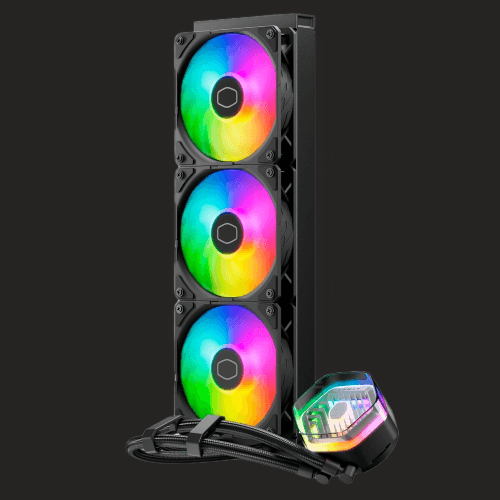







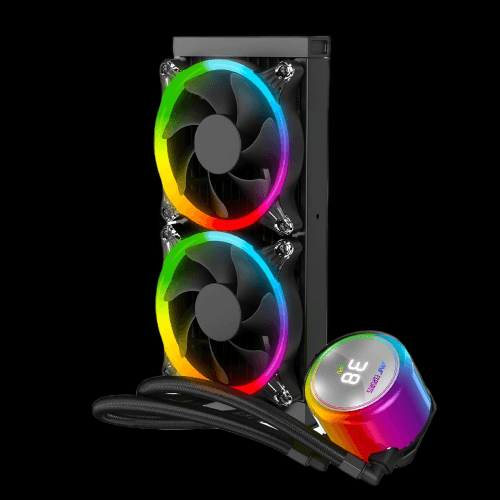







Cost: Budget-Friendly vs. Premium Investment
Cost: Budget-Friendly vs. Premium Investment
Cost: Budget-Friendly vs. Premium Investment
Cost: Budget-Friendly vs. Premium Investment
Cost: Budget-Friendly vs. Premium Investment
Cost: Budget-Friendly vs. Premium Investment
Cost: Budget-Friendly vs. Premium Investment
Air cooling systems are generally more affordable, with basic models starting as low as ₹2,000 and high-end air coolers priced around ₹10,000.
Liquid cooling systems are more expensive, with entry-level AIO coolers starting around ₹5,000 and premium models and custom loops costing upwards of ₹20,000. The higher cost reflects the advanced technology and superior performance they offer.
An affordable liquid cooler you might need:
Ant Esports ICE Chroma 240 ARGB
This Cooler features a 240mm radiator equipped with dual 120mm fans and Addressable RGB lighting, providing both efficient cooling and customizable aesthetics. It includes a real-time CPU temperature display, making it easier to monitor system performance. Compatible with a wide range of Intel and AMD sockets.
Air cooling systems are generally more affordable, with basic models starting as low as ₹2,000 and high-end air coolers priced around ₹10,000.
Liquid cooling systems are more expensive, with entry-level AIO coolers starting around ₹5,000 and premium models and custom loops costing upwards of ₹20,000. The higher cost reflects the advanced technology and superior performance they offer.
An affordable liquid cooler you might need:
Ant Esports ICE Chroma 240 ARGB
This Cooler features a 240mm radiator equipped with dual 120mm fans and Addressable RGB lighting, providing both efficient cooling and customizable aesthetics. It includes a real-time CPU temperature display, making it easier to monitor system performance. Compatible with a wide range of Intel and AMD sockets.
Air cooling systems are generally more affordable, with basic models starting as low as ₹2,000 and high-end air coolers priced around ₹10,000.
Liquid cooling systems are more expensive, with entry-level AIO coolers starting around ₹5,000 and premium models and custom loops costing upwards of ₹20,000. The higher cost reflects the advanced technology and superior performance they offer.
An affordable liquid cooler you might need:
Ant Esports ICE Chroma 240 ARGB
This Cooler features a 240mm radiator equipped with dual 120mm fans and Addressable RGB lighting, providing both efficient cooling and customizable aesthetics. It includes a real-time CPU temperature display, making it easier to monitor system performance. Compatible with a wide range of Intel and AMD sockets.
Air cooling systems are generally more affordable, with basic models starting as low as ₹2,000 and high-end air coolers priced around ₹10,000.
Liquid cooling systems are more expensive, with entry-level AIO coolers starting around ₹5,000 and premium models and custom loops costing upwards of ₹20,000. The higher cost reflects the advanced technology and superior performance they offer.
An affordable liquid cooler you might need:
Ant Esports ICE Chroma 240 ARGB
This Cooler features a 240mm radiator equipped with dual 120mm fans and Addressable RGB lighting, providing both efficient cooling and customizable aesthetics. It includes a real-time CPU temperature display, making it easier to monitor system performance. Compatible with a wide range of Intel and AMD sockets.
Air cooling systems are generally more affordable, with basic models starting as low as ₹2,000 and high-end air coolers priced around ₹10,000.
Liquid cooling systems are more expensive, with entry-level AIO coolers starting around ₹5,000 and premium models and custom loops costing upwards of ₹20,000. The higher cost reflects the advanced technology and superior performance they offer.
An affordable liquid cooler you might need:
Ant Esports ICE Chroma 240 ARGB
This Cooler features a 240mm radiator equipped with dual 120mm fans and Addressable RGB lighting, providing both efficient cooling and customizable aesthetics. It includes a real-time CPU temperature display, making it easier to monitor system performance. Compatible with a wide range of Intel and AMD sockets.
Air cooling systems are generally more affordable, with basic models starting as low as ₹2,000 and high-end air coolers priced around ₹10,000.
Liquid cooling systems are more expensive, with entry-level AIO coolers starting around ₹5,000 and premium models and custom loops costing upwards of ₹20,000. The higher cost reflects the advanced technology and superior performance they offer.
An affordable liquid cooler you might need:
Ant Esports ICE Chroma 240 ARGB
This Cooler features a 240mm radiator equipped with dual 120mm fans and Addressable RGB lighting, providing both efficient cooling and customizable aesthetics. It includes a real-time CPU temperature display, making it easier to monitor system performance. Compatible with a wide range of Intel and AMD sockets.
Air cooling systems are generally more affordable, with basic models starting as low as ₹2,000 and high-end air coolers priced around ₹10,000.
Liquid cooling systems are more expensive, with entry-level AIO coolers starting around ₹5,000 and premium models and custom loops costing upwards of ₹20,000. The higher cost reflects the advanced technology and superior performance they offer.
An affordable liquid cooler you might need:
Ant Esports ICE Chroma 240 ARGB
This Cooler features a 240mm radiator equipped with dual 120mm fans and Addressable RGB lighting, providing both efficient cooling and customizable aesthetics. It includes a real-time CPU temperature display, making it easier to monitor system performance. Compatible with a wide range of Intel and AMD sockets.
Aesthetics
Aesthetics
Aesthetics
Aesthetics
Aesthetics
Aesthetics
Aesthetics
Air Cooling: Simpler look. The heatsink and fan often take center stage in your case. Some models offer RGB lighting for a touch of personality.
Liquid Cooling: Modern and sleek. Water blocks, tubes, and radiators create a visually stunning setup, especially with customizable RGB lighting, making your PC a centerpiece.
Air Cooling: Simpler look. The heatsink and fan often take center stage in your case. Some models offer RGB lighting for a touch of personality.
Liquid Cooling: Modern and sleek. Water blocks, tubes, and radiators create a visually stunning setup, especially with customizable RGB lighting, making your PC a centerpiece.
Air Cooling: Simpler look. The heatsink and fan often take center stage in your case. Some models offer RGB lighting for a touch of personality.
Liquid Cooling: Modern and sleek. Water blocks, tubes, and radiators create a visually stunning setup, especially with customizable RGB lighting, making your PC a centerpiece.
Air Cooling: Simpler look. The heatsink and fan often take center stage in your case. Some models offer RGB lighting for a touch of personality.
Liquid Cooling: Modern and sleek. Water blocks, tubes, and radiators create a visually stunning setup, especially with customizable RGB lighting, making your PC a centerpiece.
Air Cooling: Simpler look. The heatsink and fan often take center stage in your case. Some models offer RGB lighting for a touch of personality.
Liquid Cooling: Modern and sleek. Water blocks, tubes, and radiators create a visually stunning setup, especially with customizable RGB lighting, making your PC a centerpiece.
Air Cooling: Simpler look. The heatsink and fan often take center stage in your case. Some models offer RGB lighting for a touch of personality.
Liquid Cooling: Modern and sleek. Water blocks, tubes, and radiators create a visually stunning setup, especially with customizable RGB lighting, making your PC a centerpiece.
Air Cooling: Simpler look. The heatsink and fan often take center stage in your case. Some models offer RGB lighting for a touch of personality.
Liquid Cooling: Modern and sleek. Water blocks, tubes, and radiators create a visually stunning setup, especially with customizable RGB lighting, making your PC a centerpiece.
Space Requirements
Space Requirements
Space Requirements
Space Requirements
Space Requirements
Space Requirements
Space Requirements
Air Cooling: Needs sufficient space around the CPU socket to accommodate the heatsink and fan. Larger coolers can block RAM slots or other components.
Liquid Cooling: Offers more flexibility in placement. However, the radiator and tubes still require space. Depending on your case size and design, fitting a liquid cooler can be challenging, but it allows for potentially more creative and space-efficient configurations.
Air Cooling: Needs sufficient space around the CPU socket to accommodate the heatsink and fan. Larger coolers can block RAM slots or other components.
Liquid Cooling: Offers more flexibility in placement. However, the radiator and tubes still require space. Depending on your case size and design, fitting a liquid cooler can be challenging, but it allows for potentially more creative and space-efficient configurations.
Air Cooling: Needs sufficient space around the CPU socket to accommodate the heatsink and fan. Larger coolers can block RAM slots or other components.
Liquid Cooling: Offers more flexibility in placement. However, the radiator and tubes still require space. Depending on your case size and design, fitting a liquid cooler can be challenging, but it allows for potentially more creative and space-efficient configurations.
Air Cooling: Needs sufficient space around the CPU socket to accommodate the heatsink and fan. Larger coolers can block RAM slots or other components.
Liquid Cooling: Offers more flexibility in placement. However, the radiator and tubes still require space. Depending on your case size and design, fitting a liquid cooler can be challenging, but it allows for potentially more creative and space-efficient configurations.
Air Cooling: Needs sufficient space around the CPU socket to accommodate the heatsink and fan. Larger coolers can block RAM slots or other components.
Liquid Cooling: Offers more flexibility in placement. However, the radiator and tubes still require space. Depending on your case size and design, fitting a liquid cooler can be challenging, but it allows for potentially more creative and space-efficient configurations.
Air Cooling: Needs sufficient space around the CPU socket to accommodate the heatsink and fan. Larger coolers can block RAM slots or other components.
Liquid Cooling: Offers more flexibility in placement. However, the radiator and tubes still require space. Depending on your case size and design, fitting a liquid cooler can be challenging, but it allows for potentially more creative and space-efficient configurations.
Air Cooling: Needs sufficient space around the CPU socket to accommodate the heatsink and fan. Larger coolers can block RAM slots or other components.
Liquid Cooling: Offers more flexibility in placement. However, the radiator and tubes still require space. Depending on your case size and design, fitting a liquid cooler can be challenging, but it allows for potentially more creative and space-efficient configurations.
Conclusion
Conclusion
Conclusion
Conclusion
Conclusion
Conclusion
Conclusion
Air cooling is a reliable, cost-effective, and low-maintenance option suitable for most users.
Liquid cooling offers superior cooling performance, quieter operation, and a sleek aesthetic, making it ideal for enthusiasts and those with demanding workloads. In my personal experience.
We would recommed liquid cooling to ensure optimal performance and a quieter setup. However, both options have their merits, and the right choice will depend on your priorities and budget.
Air cooling is a reliable, cost-effective, and low-maintenance option suitable for most users.
Liquid cooling offers superior cooling performance, quieter operation, and a sleek aesthetic, making it ideal for enthusiasts and those with demanding workloads. In my personal experience.
We would recommed liquid cooling to ensure optimal performance and a quieter setup. However, both options have their merits, and the right choice will depend on your priorities and budget.
Air cooling is a reliable, cost-effective, and low-maintenance option suitable for most users.
Liquid cooling offers superior cooling performance, quieter operation, and a sleek aesthetic, making it ideal for enthusiasts and those with demanding workloads. In my personal experience.
We would recommed liquid cooling to ensure optimal performance and a quieter setup. However, both options have their merits, and the right choice will depend on your priorities and budget.
Air cooling is a reliable, cost-effective, and low-maintenance option suitable for most users.
Liquid cooling offers superior cooling performance, quieter operation, and a sleek aesthetic, making it ideal for enthusiasts and those with demanding workloads. In my personal experience.
We would recommed liquid cooling to ensure optimal performance and a quieter setup. However, both options have their merits, and the right choice will depend on your priorities and budget.
Air cooling is a reliable, cost-effective, and low-maintenance option suitable for most users.
Liquid cooling offers superior cooling performance, quieter operation, and a sleek aesthetic, making it ideal for enthusiasts and those with demanding workloads. In my personal experience.
We would recommed liquid cooling to ensure optimal performance and a quieter setup. However, both options have their merits, and the right choice will depend on your priorities and budget.
Air cooling is a reliable, cost-effective, and low-maintenance option suitable for most users.
Liquid cooling offers superior cooling performance, quieter operation, and a sleek aesthetic, making it ideal for enthusiasts and those with demanding workloads. In my personal experience.
We would recommed liquid cooling to ensure optimal performance and a quieter setup. However, both options have their merits, and the right choice will depend on your priorities and budget.
Air cooling is a reliable, cost-effective, and low-maintenance option suitable for most users.
Liquid cooling offers superior cooling performance, quieter operation, and a sleek aesthetic, making it ideal for enthusiasts and those with demanding workloads. In my personal experience.
We would recommed liquid cooling to ensure optimal performance and a quieter setup. However, both options have their merits, and the right choice will depend on your priorities and budget.
